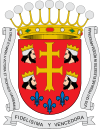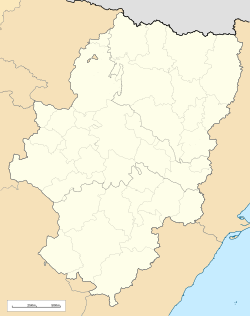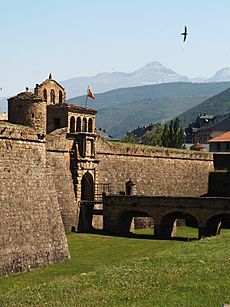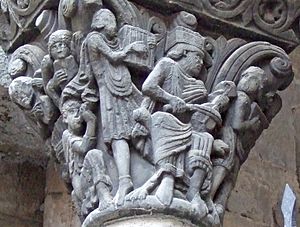Jaca facts for kids
Quick facts for kids
Jaca
Chaca (Aragonese)
Xaca (Aragonese) |
|||
|---|---|---|---|
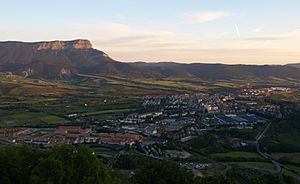
Jaca as viewed from the Rapitan fort.
|
|||
|
|||
| Country | Spain | ||
| Autonomous community | Aragon | ||
| Province | Huesca | ||
| Comarca | La Jacetania | ||
| Area | |||
| • Total | 406.34 km2 (156.89 sq mi) | ||
| Elevation | 820 m (2,690 ft) | ||
| Population
(2018)
|
|||
| • Total | 12,813 | ||
| • Density | 31.5327/km2 (81.669/sq mi) | ||
| Time zone | UTC+1 (CET) | ||
| • Summer (DST) | UTC+2 (CET) | ||
Jaca is a cool city in northeastern Spain. It's located in the Huesca province, close to the amazing Pyrenees mountains and the border with France. Jaca sits by the Aragón River.
Long ago, Jaca was an important fort. It was a meeting point for two big travel routes in the Middle Ages. These routes connected cities like Toulouse and Pau to Santiago de Compostela and Zaragoza. Jaca was also where the County and later the Kingdom of Aragon began. It was the first capital city of the Kingdom of Aragon until 1096. It was also the main city of the Jacetania region.
Contents
Villages Near Jaca
Besides the main town of Jaca, there are many smaller villages. These villages are part of the Jaca area. One famous village is Astún, which is a popular ski resort.
Jaca's Long History
Ancient Roots of Jaca
The exact beginnings of Jaca are a bit of a mystery. Its name likely comes from the Iacetani people. These were small tribes living in the Ebro river area. A historian named Strabo mentioned them long ago.
Jaca was also a place where coins were made. This happened from the second half of the 2nd century BC. Some of these ancient coins are now in the British Museum. They show a bearded head on one side and a horseman with a spear on the other.
Roman Rule and Beyond
In 195 BC, the Roman consul Cato the Elder started to conquer Jaca. The Romans took control of the city by 194 BC. After the Romans, the Visigothic nobles ruled most of Spain.
In 720, Muslim forces conquered Huesca. Their advance into Europe slowed down after the Battle of Tours in 732. The Jaca region became a buffer zone. This meant it was a neutral area between the Carolingian Empire and Muslim lands.
Becoming a Kingdom's Capital
Around 799, a leader named Aureolo created an independent county in the area. This county slowly grew. Later, Ramiro I of Aragon (who ruled from 1035 to 1063) made Jaca a city. He also made it the capital of the new Kingdom of Aragon.
In 1063, an important meeting called the Synod of Jaca took place here. As the Kingdom of Aragon grew south, conquering more land, the capital moved. In 1096, Huesca became the new capital. Even though Jaca was no longer the capital, it remained important. It continued to be a busy market city and a center for services in its region.
Challenges and New Fortifications
The late Middle Ages brought tough times to Jaca. Plagues and fires caused a lot of problems. The city struggled until Ferdinand the Catholic helped set up a new local government. This helped the city's middle class, and many became supporters of artists. You can still see their work in the cathedral today.
Jaca also became a strong military post. It was important for defending the Spanish kingdoms from possible French attacks. In 1592, King Philip II ordered the building of several fortresses in the Pyrenees. One of these was the amazing pentagonal Jaca citadel. It was designed by an Italian engineer named Tibúrcio Spannocchi.
Jewish Community and Modern History
During the Middle Ages, Jaca was home to Aragon's oldest Jewish community. Sadly, this community ended in 1492. This was when the Jews were expelled from Spain.
Much later, in 1930, an event called the Jaca uprising happened. Leaders of this mutiny wanted to end the monarchy. The uprising was stopped, but it was an early sign of the troubles that led to the Spanish Civil War.
Jaca's Climate
Jaca has a climate that is a mix of Mediterranean and continental weather. This is because the city is quite high up, at 820 meters (about 2,690 feet). Winters are cool, and summers are warm. Daytime temperatures can be hot, but nights are usually cool.
There isn't a truly dry season. The most rain falls in autumn and spring. On average, Jaca gets about 768 millimeters (30 inches) of rain each year. Frost is common, and it often snows from late November to early March. Heavy snowfalls can happen during very cold periods. The average yearly temperature in Jaca is 12.2 degrees Celsius (54 degrees Fahrenheit).
| Climate data for Jaca, 1981–2010 | |||||||||||||
|---|---|---|---|---|---|---|---|---|---|---|---|---|---|
| Month | Jan | Feb | Mar | Apr | May | Jun | Jul | Aug | Sep | Oct | Nov | Dec | Year |
| Mean daily maximum °C (°F) | 9.5 (49.1) |
11.0 (51.8) |
14.7 (58.5) |
16.2 (61.2) |
20.5 (68.9) |
25.7 (78.3) |
29.4 (84.9) |
29.0 (84.2) |
24.4 (75.9) |
19.0 (66.2) |
13.2 (55.8) |
9.8 (49.6) |
18.5 (65.4) |
| Daily mean °C (°F) | 4.4 (39.9) |
5.3 (41.5) |
8.3 (46.9) |
10.0 (50.0) |
14.0 (57.2) |
18.4 (65.1) |
21.6 (70.9) |
21.3 (70.3) |
17.5 (63.5) |
13.2 (55.8) |
7.9 (46.2) |
4.9 (40.8) |
12.2 (54.0) |
| Mean daily minimum °C (°F) | −0.8 (30.6) |
−0.4 (31.3) |
1.8 (35.2) |
3.7 (38.7) |
7.5 (45.5) |
11.1 (52.0) |
13.7 (56.7) |
13.6 (56.5) |
10.6 (51.1) |
7.3 (45.1) |
2.6 (36.7) |
0.0 (32.0) |
5.9 (42.6) |
| Average precipitation mm (inches) | 57.9 (2.28) |
48.9 (1.93) |
47.8 (1.88) |
82.2 (3.24) |
76.4 (3.01) |
48.6 (1.91) |
37.4 (1.47) |
43.2 (1.70) |
68.2 (2.69) |
89.6 (3.53) |
89.0 (3.50) |
79.3 (3.12) |
768.5 (30.26) |
| Average precipitation days (≥ 1 mm) | 10.0 | 8.7 | 8.6 | 11.8 | 12.5 | 7.1 | 6.1 | 6.4 | 7.5 | 10.9 | 11.3 | 11.0 | 111.9 |
| Source: World Meteorological Organization (WMO) | |||||||||||||
Main Sights in Jaca
Jaca has many interesting old buildings to explore.
- Medieval Walls and Towers: You can see parts of the old walls and towers that once protected the city.
- Jaca Cathedral: This beautiful cathedral was built in the 11th century. It's a great example of Romanesque style.
- Jaca Citadel: This impressive fortress was built in the late 1500s. It has a unique five-sided shape. Fun fact: a group of rock sparrows lives there!
- Diocesan Museum of Jaca: This museum is also known as the Museum of Medieval Sacred Art. It keeps and displays amazing old frescos (wall paintings). Some of these paintings were found in very remote places around Jaca.
Tourism and Sports in Jaca
Jaca is a popular spot for tourists. Many people visit for summer holidays or to enjoy winter sports.
Jaca as a Mountain Sports Hub
In the 1970s, Jaca changed a lot. It went from a small town to a gateway for mountain sports. There are two big winter resorts nearby: Valle de Astun and Candanchu. They are both about 30 kilometers (18 miles) from the city.
This growth brought new buildings and roads. While it helped the economy, some people felt the town lost some of its original charm. The changes had a big impact on the Aragon Valley. Many people who used to be small farmers now work in tourism and services.
Hosting International Sports Events
Jaca has hosted several important sports events.
- It hosted the Winter Universiade (a sports event for university students) in 1981 and 1995.
- The city also hosted the 2007 European Youth Olympic Winter Festival.
Jaca is very popular for winter sports. Because of this, the city tried to host the Winter Olympics several times. It bid for the 1998, 2002, 2010, and 2014 Winter Olympics. However, the games were awarded to other cities like Nagano, Salt Lake City, Vancouver, and Sochi.
Gallery
See also
 In Spanish: Jaca para niños
In Spanish: Jaca para niños



